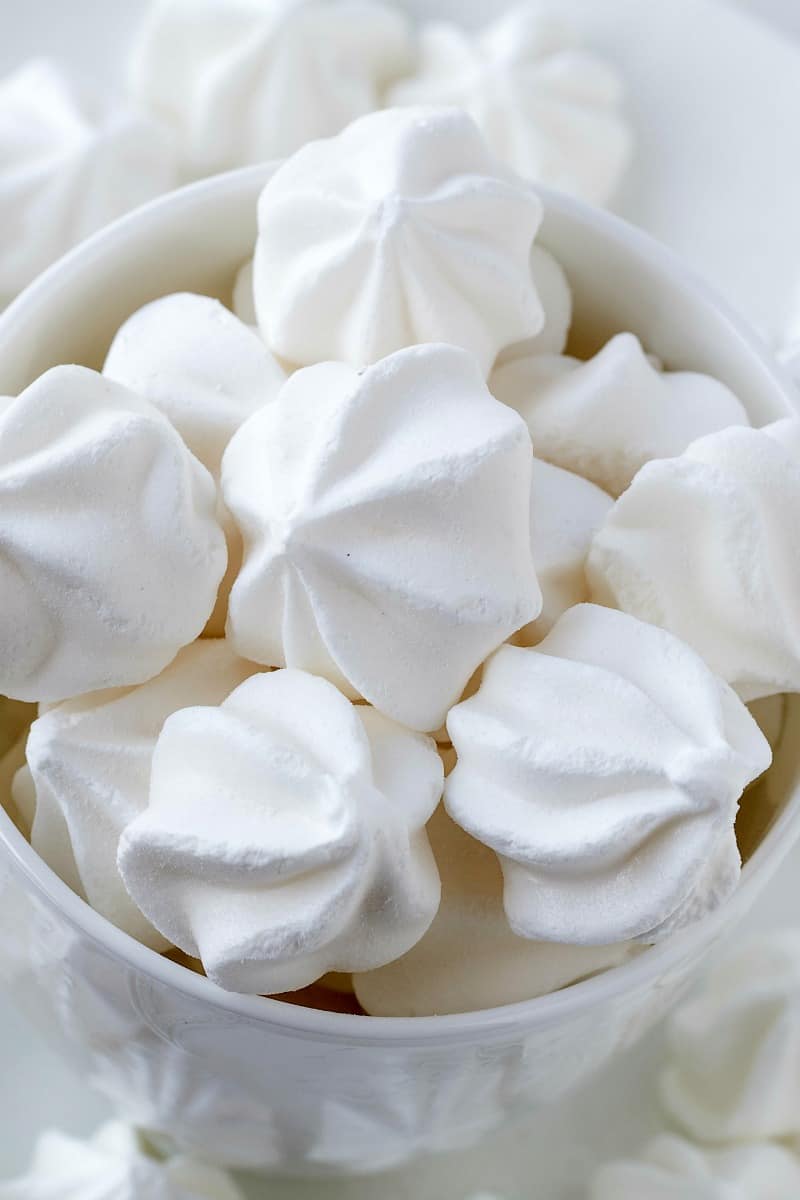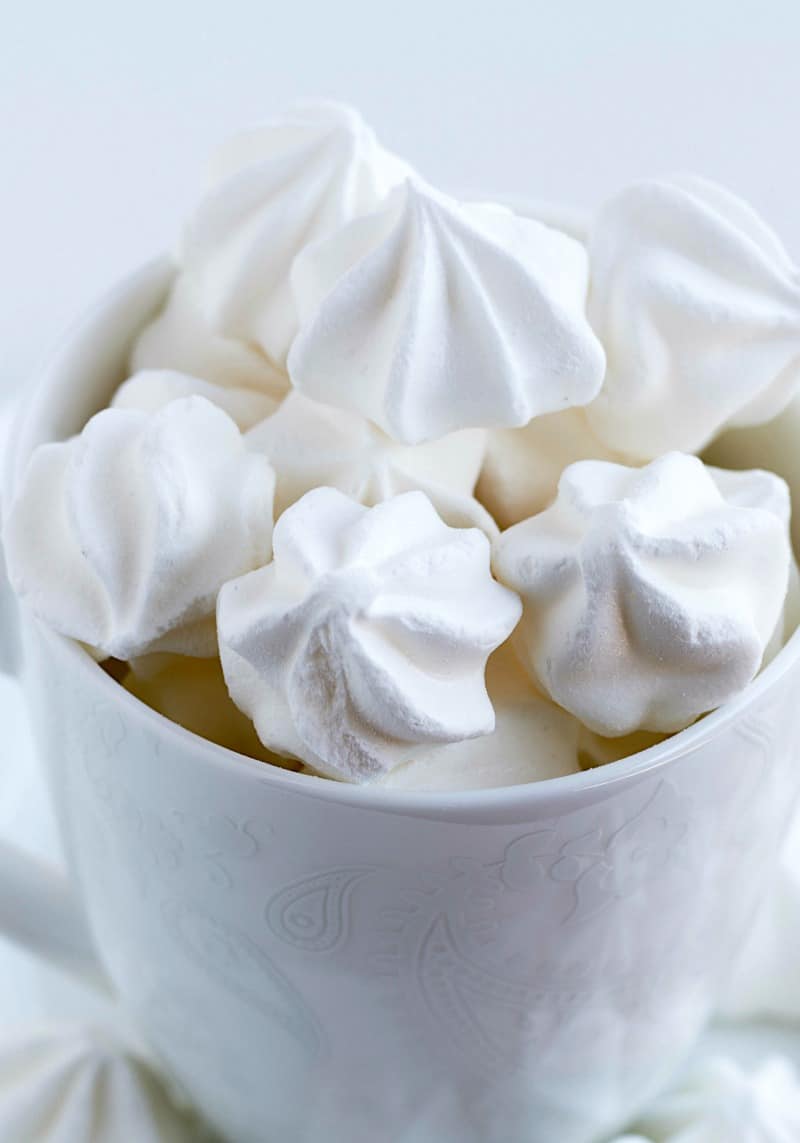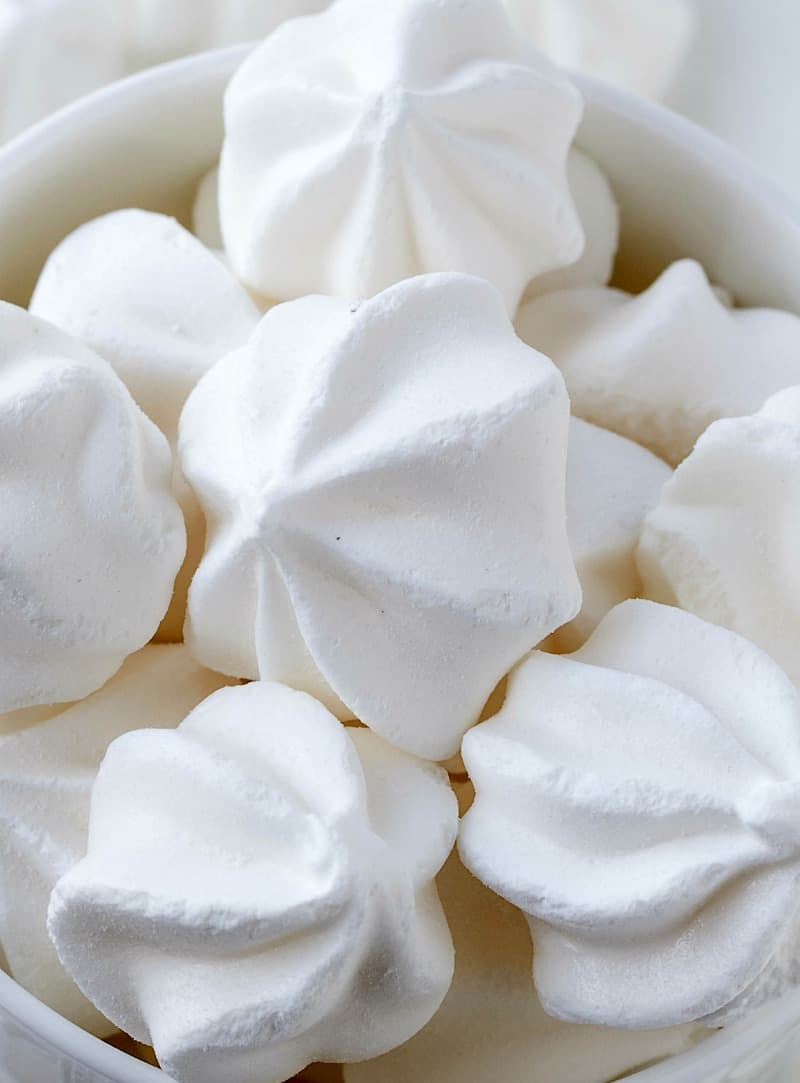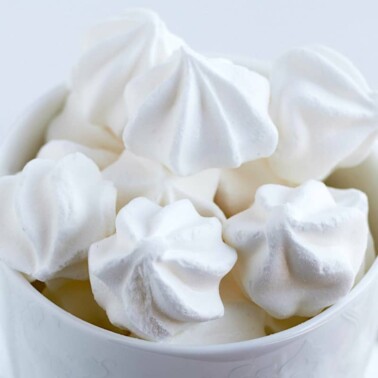Aquafaba Meringue
This post may contain affiliate links. See my disclosure policy.
Learn how to make light and fluffy aquafaba meringue using chickpea aquafaba and vanilla. It’s a fun, creative twist on classic meringue with NO egg whites required!
Ready to use your aquafaba meringue? Try it in my chocolate babka and lemon meringue pie!

Looking for a vegan version of meringue cookies? Look no further than these aquafaba cookies!
If you ever thought it was impossible to make meringue without egg whites, this recipe will convince you otherwise. In fact, I can safely say these vegan meringue cookies are as good (if not better) as the original.
What is aquafaba?
Aquafaba (‘aqua’ meaning water and ‘faba’ meaning beans) is the viscous liquid that remains after cooking beans or legumes, most commonly chickpeas. This chickpea liquid is full of protein, similar to egg whites, and when it’s whipped with a stabilizer, you get a light and fluffy mixture similar to whipped egg whites.
Table of Contents
Why I love this recipe
- Less work. No more carefully separating egg whites. Just drain the chickpeas, and you’re good to go.
- Easy to customize. I kept this recipe simple with a bit of vanilla, but there’s plenty of room to customize the cookies with colors or flavorful extracts.
- Perfect texture and flavor. The cookies turn out crisp on the outside but with the perfect tender center and delightfully sweet flavor.
- Great for sharing. These cookies are naturally vegan, gluten-free, and travel well, so they’re perfect for bringing to get-togethers when you’re not certain of everyone’s dietary restrictions.
Ingredients needed
- Aquafaba. AKA the liquid from a strained can of chickpeas. Make sure to use chickpeas with no added salt. Save the chickpeas for roasting or blend them into my chickpea cookie dough.
- Sugar. Regular white sugar works perfectly.
- Cream of tartar. To stabilize the aquafaba so it keeps its fluffy texture.
- Vanilla extract. For flavor.
How to make aquafaba meringue
I’ve included step-by-step photos below to make this recipe easy to follow at home. For the full printable recipe instructions and ingredient quantities, scroll to the recipe card at the bottom of this post.
Step 1- Prep. Preheat the oven to 200F/100C and line a large baking sheet with parchment paper.
Step 2- Make aquafaba. In a large bowl or stand mixer with a whisk attachment, add the chickpea water. Beat the liquid until soft peaks form.
Step 3- Finish the meringue. To the meringue mixture, slowly add the sugar, vanilla extract, and cream of tartar. Continue beating until stiff peaks form.
Step 4- Shape. Transfer the mixture into a piping bag fitted with a star tip. Pipe bite-sized portions of meringue onto the lined baking tray. If you don’t have a piping bag, a spoon will work just as well.
Step 5- Bake. Bake the cookies for 60 minutes or until they are crisp yet tender on the outside. Once the cookies are done, remove them from the oven and let them cool completely.

Arman’s recipe tips
- Strain the chickpeas. Even the tiniest remnant of chickpea in the aquafaba will make it much harder to form stiff peaks.
- Vary the baking time. Everyone’s oven works differently, so your cookies may take less or more time to bake. You’ll know they’re done baking when they’re crisp on the outside but still soft when you press them.
- Bake large cookies. I made 30 small cookies, but you could make 12-15 large cookies if you prefer. Just remember the baking time will vary. When I bake large cookies, I’ve found they can take upwards of 90 minutes to bake.
Flavor variations
- Add extracts. In addition to the vanilla extract, add a few drops of lemon extract, peppermint extract, or almond extract to switch up the flavor.
- Garnish. Dust the fresh meringues with cocoa powder, lemon zest, or crushed peppermint candies, depending on the flavor you’re after.
- Make them colorful. I’m boring and like plain white meringue cookies, but I see no reason why you shouldn’t add a few drops of food coloring for fun!
- Dip them in chocolate. Once the cookies have cooled completely, dip them in melted chocolate and leave them as is, or top them with crushed hazelnuts, pistachios, or shredded coconut.
Storage instructions
To store: Meringue cookies should be stored in an airtight container at room temperature for up to 1 month.
To freeze: Believe it or not, it’s easy to freeze meringue cookies. Just transfer them to a freezer-safe container and freeze them for up to 6 months. Make sure to seal the bag completely, as any moisture that leaks in will make the meringue soft. Let them thaw overnight in the fridge before enjoying.

Frequently asked questions
Your aquafaba may not be whipping if there are bits of chickpeas mixed in the liquid or if you did not add enough cream of tartar. It also takes at least 3-4 minutes for soft peaks to form, so it may just be a matter of time.
Aquafaba requires a stabilizing agent (like cream of tartar, vinegar, or lemon juice) in order to stay light and fluffy. If the meringues melt, it could be because there wasn’t enough stabilizer added.
Yes, if you need to keep your aquafaba fresh, I recommend freezing it in ice cube trays and storing it in a freezer-safe container for up to 1 month. Let it thaw overnight in the fridge, then whip it as you would fresh.
More vegan sweets
- Vegan brownies
- Eggless chocolate chip cookies
- Vegan cookie dough
- Raspberry bread
- Or any of my vegan dessert recipes

Aquafaba Meringue
Ingredients
- 3/4 cup aquafaba * See notes
- 1/2 cup sugar white or uncut white sugar
- 1/4 teaspoon cream of tartar
- 1 teaspoon vanilla extract
Instructions
- Preheat the oven to 100C/200F. Line a baking tray with parchment paper, and set aside.
- In a large mixing bowl, add your aquafaba and using a stick mixer, beat together until soft peaks form.
- Slowly add the sugar, vanilla extract, and cream of tartar, while continuing to beat until stiff peaks form.
- Transfer the mixture into a piping bag fitted with a star tip. Pipe bite sized portions of meringue onto the lined baking sheet.
- Bake the meringues for 60 minutes, or until crisp and tender on the outside. Once cooked, remove from the oven and let cool completely.













